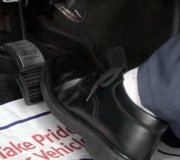Hi,
When you bled the brakes, is this the procedure you followed?
2009 Infiniti G37 Sedan V6-3.7L (VQ37VHR)
Procedures
Vehicle Brakes and Traction Control Hydraulic System Brake Bleeding Service and Repair Procedures
PROCEDURES
BRAKE FLUID
Bleeding Brake System
CAUTION:
- Turn the ignition switch OFF and disconnect the ABS actuator and electric unit (control unit) connector or the battery negative terminal before performing the work.
- Monitor the fluid level in the reservoir tank while performing the air bleeding
- Always use new brake fluid for refilling. Never reuse the drained brake fluid.
1. Connect a vinyl tube to the bleeder valve of the rear right brake.
2. Fully depress the brake pedal 4 to 5 times.
3. Loosen the bleeder valve and bleed air with the brake pedal depressed, and then quickly tighten the bleeder valve.
4. Repeat steps 2 and 3 until all of the air is out of the brake line.
5. Tighten the bleeder valve to the specified torque.
- Front disc brake
- 2 piston type
- 4 piston type
- Rear disc brake
- 1 piston type
- 2 piston type
6. Perform steps 1 to 5 for the rear right brake to front left brake to rear left brake to and front right brake in order.
7. Check that the fluid level in the reservoir tank is within the specified range after air bleeding. Refer to See: Brake Fluid > Procedures > Inspection.
8. Check each item of brake pedal. Adjust it if the measurement value is not the standard. Refer to See: Brake Pedal Assy > Initial Inspection and Diagnostic Overview > Inspection and Adjustment.
Let me know.
Joe
Monday, September 21st, 2020 AT 5:53 PM



